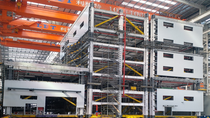Sustainability
A 21st century factory: bespoke, modular and sustainable

When BASF decided to build a new state-of-the-art plant to support its growing plastic additives business, it sought to realize its plans quickly, safely and efficiently. BASF technologists and engineers determined to apply these and the sustainability benefits of modular construction to this large, specialized project.
Modular construction uses self-contained units that are manufactured with their components, such as services and equipment, already inside. Once completed, the modules are transferred and joined together at their final location. Modular building is commonly used for structures that have many units of the same type, such as residential apartment blocks.
BASF engineers set to work planning how the complex requirements of the new factory could be met by a modular approach. In a first for BASF, they designed the ten modular units forming the factory core and calculated the exact dimensions, weight and strength required for each unit to accommodate and support the equipment and services specific to its unique role within the final design.
A modular approach also delivered several environmental benefits. As construction takes place within a single controlled location, modular building can reduce waste, cut energy costs, minimize air and water pollution and reduce safety concerns.
Operational sustainability of the factory is an essential part of the design too. For example, the plant will reuse much of its process water, reducing the amount of water that is used as well as cutting the amount of energy and equipment needed to treat waste water during the entire lifetime of the plant.
Working together, the technology and engineering teams produced bespoke designs that could be built quickly and safely. The ten units took just 230 days to build. Constructing the units in a designated supplier workshop meant that we were able to improve both quality and efficiency. For example, no scaffolding was needed; thus 12 workers could be placed on other jobs. About 300 kg of metal that might have been sent to scrap on a job site, was recycled. Safety could also be tightly controlled. There were no injuries during the 1.2 million hours of the project.
On completion the ten units, weighing 2000 tons and standing 30 meters high, were transported by sea and road for 24 hours to their final destination in Shanghai. Building the factory units offsite also meant that the foundations and plant units could be constructed concurrently, rather than one after the other. On arrival the units were assembled in just five days. Using all these strategies, the team was able to deliver the project in just 10 months - half the time of an onsite build.
In Shanghai, all new buildings must have at least 40% modular components. The new BASF factory Is about 90% modular. With modular building proving it can bring a host of commercial and environmental benefits to projects quickly, it’s an approach that is likely to be increasingly adopted, even for the most complicated builds.
“It was exciting to be able to apply creative thinking and bring all the business and environmental benefits of modular design and build to this bespoke and complex project,” says Hermann Althoff, BASF's Senior Vice President, Performance Chemicals Asia Pacific. “Getting a project completed quickly and safely is always going to be a business win, especially when we can guarantee the long term operational and environmental performance. This project has redefined out-of-the-box thinking.”